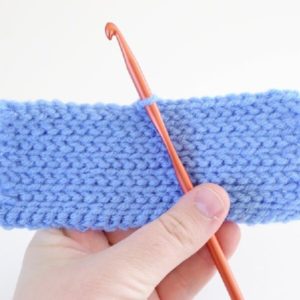How to Slip Stitch Crochet
Jump To:
The slip stitch is a crochet stitch requiring a lot of work but gets lost in the shuffle of stitches and may look complex if you are a beginner learning how to crochet. When you think of fundamental crochet stitches, single crochet (SC), double crochet (DC), and half-double crochet (HDC) come to mind (HDC). Along with the stitches that flow from them, they are frequently the stars of the show.

What is a SL ST Crochet Stitch
Because it isn’t considered a full-on stitch, slip is rarely discussed. Slip stitch, often known as SL ST, is a workhorse that gets the job done. It’s easy to overlook it, but it’s crucial! It’s a low-profile stitch that adds practically little height to your crochet creation but serves a valuable purpose.
What can you make with SL ST stitch?
When it comes to crocheting in the round, the SL ST stitch is crucial. The slip stitch is used to finish one row before going on to the next in any tube-shaped crochet object, such as coffee cup cozies, beanies, and cowls. Doilies, placemats, mandalas, and other flat circle crafts are the same.
Unless your craft is spiraled, you’ll need to use a slip stitch. The slip stitch is highly crucial in amigurumi since it is used to link rows and shape the various elements of the toys. This stitch allows us to make the tiniest adjustments, increases, and reductions that other stitches can’t.
Things to know about SL ST stitch
One can also use a slip stitch to join elements of a crocheted object together, such as combining granny squares into blankets or stripes of a mile-a-minute afghan into a whole throw or attaching the sleeves of a garment to its body.
While the slip stitch commonly involves joining rows or sections together, one may also use it in crochet work.
Despite its low height, the SL ST stitch can carry a project and, when combined with a BLO (back loop only) variant, may provide aesthetic intrigue to your crochet project.
Here is how to crochet a slip stitch
- Insert your hook (front to back) into the second stitch from the hook after you form a chain.
- Draw the loop through both the loop and the chain on the hook and yarn over.
- You’ve got an SL ST!
To proceed with the rest of that row once you’ve crocheted your first SL ST, do the following:
- Insert your hook into the next loop in the chain (front to back).
- Yarn over and pull the loop and chain on the hook through.
- The second stitch is all yours!
- Proceed in the same manner for the rest of the row.
Here is how to crochet SL ST on the top of another row
- Make a loop to elevate yourself to the height of the stitch you’re using when you’re through with the first row and want to start the second.
- You’ll only need one chain because SL ST is only one loop tall.
- If you’re beginning at the beginning of the row, you’ll start with CH 1. (to create the first SL ST).
- Then crochet over and draw the loop through both the loop and the chain on the hook before inserting the hook into the next stitch (front to back).
- Then do the same thing for the rest of the row.
What does it mean to slip stitch in crochet?
A slip stitch has very little height. It is used to join stitches that are worked in rounds such as a granny square. It is also used to travel to another part of a row without producing any visible stitches (such as indenting an armhole on a sweater).
How do you crochet two pieces with a slip stitch?
Is a slip stitch the same as single crochet?
English single crochet (sc) would translate as a slip stitch (sl st) in American patterns. Treble crochet (tr) in a vintage pattern, such as those found in Weldon’s, would translate to double crochet (dc) in current American patterns.
What is a slip stitch used for?
Also known as the “Ladder Stitch,” you can use Slip stitching primarily for creating seams that should be invisible and an excellent way to sew outside of a garment. It would be a perfect stitch for closing handmade pillows or stuffed plush animals, for example!
